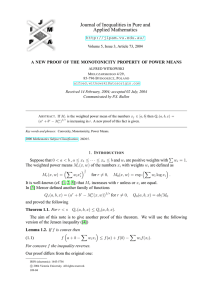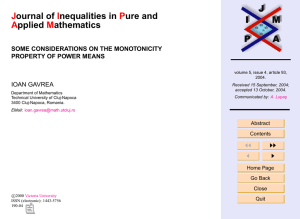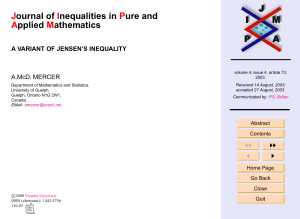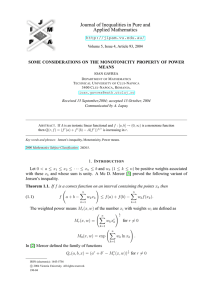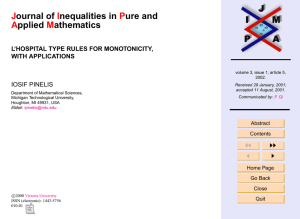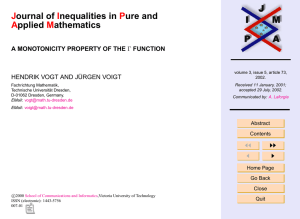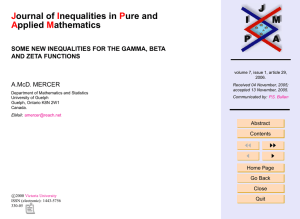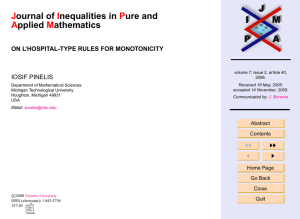J I P A
advertisement
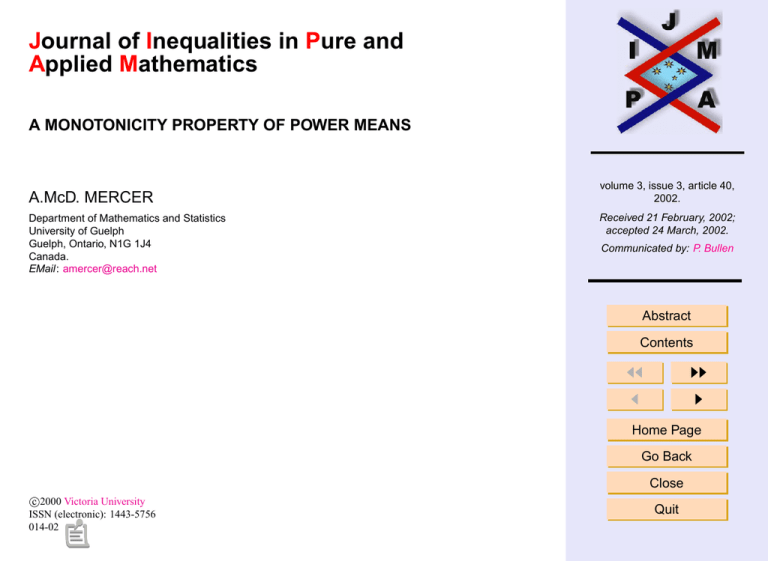
Journal of Inequalities in Pure and Applied Mathematics A MONOTONICITY PROPERTY OF POWER MEANS A.McD. MERCER Department of Mathematics and Statistics University of Guelph Guelph, Ontario, N1G 1J4 Canada. EMail: amercer@reach.net volume 3, issue 3, article 40, 2002. Received 21 February, 2002; accepted 24 March, 2002. Communicated by: P. Bullen Abstract Contents JJ J II I Home Page Go Back Close c 2000 Victoria University ISSN (electronic): 1443-5756 014-02 Quit Abstract If A and G are the arithmetic and geometric means of the numbers xj ∈ (a, b), a family of inequalities is derived of which a + b − A > ab/G is a special case. These inequalities demonstrate a new monotonicity property for power means. 2000 Mathematics Subject Classification: 26D15 Key words: Arithmetic mean, Geometric mean, Monotonicity, Power means. A Monotonicity Property of Power Means Contents 1 Introduction . . . . . . . . . . . . . . . . . . . . . . . . . . . . . . . . . . . . . . . . . 2 The Main Result . . . . . . . . . . . . . . . . . . . . . . . . . . . . . . . . . . . . . References A.McD. Mercer 3 6 Title Page Contents JJ J II I Go Back Close Quit Page 2 of 10 J. Ineq. Pure and Appl. Math. 3(3) Art. 40, 2002 http://jipam.vu.edu.au 1. Introduction Let A, G and H be the arithmetic, geometric and harmonic means of the positive numbers x1 ≤ x2 ≤ ... ≤ xn formed with the positive weights wk whose sum is unity. Then the following inequalities were proved in [5]. If x−G x−G and Q(x) ≡ , 2x[x − A] 2x[x − G] − 2G[A − G] P (x) ≡ A Monotonicity Property of Power Means then (1.1) P (x1 ) n X 2 wk (xk − A) > A − G > P (xn ) 1 n X wk (xk − A)2 1 Title Page and (1.2) A.McD. Mercer Q(x1 ) n X 1 2 wk (xk − G) > A − G > Q(xn ) n X Contents 2 wk (xk − G) , 1 provided that at least two of the xk are distinct. These inequalities improved similar ones which were proved in [1], [3] and [6]. Instead of the multipliers P and Q appearing here, the earlier results had (2x1 )−1 and (2xn )−1 appearing in the upper and lower bounds respectively, in each of (1.1) and (1.2). Now these inequalities imply that P (x1 ) > P (xn ) and Q(x1 ) > Q(xn ) and it is a simple matter to see that these in turn are each equivalent to the inequality x1 xn (1.3) x1 + xn − A > . G JJ J II I Go Back Close Quit Page 3 of 10 J. Ineq. Pure and Appl. Math. 3(3) Art. 40, 2002 http://jipam.vu.edu.au It would seem to be of interest to give a proof of this in its own right but as well as doing that we shall also introduce a family of inequalities of which (1.3) is a special case. That is the purpose of this note. Note. In all that follows we shall suppose that 0 < a < b and that a ≤ x1 ≤ x2 ≤ · · · ≤ xn ≤ b with at least one of the xk satisfying a < xk < b. We now prove a slight generalization of (1.3). Lemma 1.1. ab (1.4) a+b−A> . G Proof. Since (b − t)(t − a) is non-negative for a ≤ t ≤ b , division by t gives ab (with equality only if t = a or t = b). t Put t = xk for k = 1, 2, . . . , n. Forming the arithmetic mean on the left and the geometric mean on the right completes the proof of the lemma. a+b−t≥ We next look at some consequences of this inequality. Making the substitutions a → a−1 , b → b−1 , xk → x−1 k in it and taking inverses extends (1.4) to −1 ab a+b−A> > a−1 + b−1 − H −1 . G With r > 0, we substitute a → ar , b → br , xk → xrk in this and then raise all three members to the power 1r . We get r1 − r1 X X ab −r ar + b r − wk xrk > > a + b−r − wk x−r . k G A Monotonicity Property of Power Means A.McD. Mercer Title Page Contents JJ J II I Go Back Close Quit Page 4 of 10 J. Ineq. Pure and Appl. Math. 3(3) Art. 40, 2002 http://jipam.vu.edu.au Now introducing the notation (1.5) r1 X Qr (a, b, x) ≡ ar + br − wk xrk for all real r 6= 0, these last inequalities read (1.6) Qr (a, b, x) > Q0 (a, b, x) > Q−r (a, b, x) for r > 0, where we have written Q0 (a, b, x) for the limit limr→0 Qr (a, b, x) whose value is easily seen to be ab . G A Monotonicity Property of Power Means A.McD. Mercer Title Page Contents JJ J II I Go Back Close Quit Page 5 of 10 J. Ineq. Pure and Appl. Math. 3(3) Art. 40, 2002 http://jipam.vu.edu.au 2. The Main Result The considerations of the previous section lead us to formulate the following theorem. Theorem 2.1. Let +∞ > r > s > −∞. Then b > Qr (a, b, x) > Qs (a, b, x) > a. (2.1) Note. From (1.5) we see that Qr (a, b, x) can be written as A Monotonicity Property of Power Means 1 Qr (a, b, x) ≡ (ar + br − Mrr (x, w)) r , A.McD. Mercer where Mr (x, w) is the ‘power mean’ of the numbers xk with weights wk defined by Title Page Mr (x, w) = X wk xrk r1 (r 6= 0) and M0 (x, w) = lim Mr (x, w). r→0 For the various properties of these means we refer the reader to [2] or [4]. In particular, it is well-known that they have the monotonicity property: xn > Mr (x, w) > Ms (x, w) > x1 (+∞ > r > s > −∞) Contents JJ J II I Go Back Close Quit and so writing (2.1) as r r b > (a + b − Page 6 of 10 1 Mrr (x, w)) r s s 1 s > (a + b − Ms (x, w)) > a, J. Ineq. Pure and Appl. Math. 3(3) Art. 40, 2002 we see that this is another monotonicity property of power means. http://jipam.vu.edu.au Proof of the theorem. There are three cases which remain to be considered: (a) r > s > 0, (b) 0 > r > s, (c) r > 0 > s. Once these are proved it is a simple matter to verify that lim Qr (a, b, x) = b and r→+∞ lim Qr (a, b, x) = a, r→−∞ giving the upper and lower bounds in the theorem. The cases (b) and (c) follow easily from (a) and (1.5) above. So let us suppose the truth of case (a) for the moment and dispose of these other cases first. (a) reads 1 1 X X r r r r s s s s wk xk when r > s > 0. a +b − wk xk > a + b − If we make the substitutions a → a−1 , b → b−1 , xk → x−1 k in this and then invert both sides it reads a −r +b −r − X wk x−r k − r1 < a −s +b −s − X wk x−s k − 1s when − r < −s < 0. A Monotonicity Property of Power Means A.McD. Mercer Title Page Contents JJ J II I Go Back Close Quit Page 7 of 10 Writing r = −p and s = −q this reads J. Ineq. Pure and Appl. Math. 3(3) Art. 40, 2002 Qq (a, b, x) > Qp (a, b, x) when 0 > q > p http://jipam.vu.edu.au which is case (b). The case (c) where r > 0 > s has two subcases namely |r| > |s| and |s| > |r|. The former follows by noting that Qr (a, b, x) > Q−s (a, b, x) > Qs (a, b, x) by virtue of (a) and (1.5). The latter follows since Qr (a, b, x) > Q−r (a, b, x) > Qs (a, b, x) by virtue of (1.5) and (b). So the cases (b) and (c) have been dealt with. It now remains to give the proof of case (a) and it is sufficient to prove that (2.2) aα + b α − X wk xαk α1 > a+b− X wk xk A Monotonicity Property of Power Means for α > 1. For once this is proved (a) follows on putting α = rs , making the substitutions a → as , b → bs , xk → xsk and then raising each side to the power 1s . We now proceed to prove (2.2). Let 1 X X α α α α V = a +b − wk xk − a+b− wk xk and differentiate this with respect to some particular xj which satisfies a < xj < b. We get 1−α X dV α α α α = a +b − wk xk −wj xα−1 + wj . j dxj After a few lines the right side reduces to x α−1 j wj 1 − Z A.McD. Mercer Title Page Contents JJ J II I Go Back Close Quit Page 8 of 10 J. Ineq. Pure and Appl. Math. 3(3) Art. 40, 2002 http://jipam.vu.edu.au P 1 where, for brevity, we have written Z ≡ (aα + bα − wk xαk ) α . dV So we see that dx is positive or negative in case xj is less than (greater j than) Z. So V will decrease if xj < Z and xj decreases, or if xj > Z and xj increases. Also, by differentiating |Z − xj | with respect to xj we find that this derivative is 1−α X α α−1 α α α ∓ wj xj a +b − wk xk +1 in case xj is less than (greater than) Z. Hence, if xj is less than (greater than) Z it will remain so as xj decreases (increases). These considerations lead us to proceed as follows: Taking those xk which lie strictly between a and b in the order of increasing subscript we let them tend to a or b, one by one, according to the rules: (i) if xk is less than the current Z let xk → a. (ii) if xk is greater than or equal to the current Z let xk → b. In this way we produce a strictly decreasing sequence whose first member is V and whose last member contains no xk ’s at all. We conclude that α1 X X V = aα + b α − wk xαk − a+b− wk xk 1 > [(1 − W1 )aα + (1 − W2 )bα ] α − [(1 − W1 )a + (1 − W2 )b], where W1 and W2 are positive numbers with W1 + W2 = 1. But this last expression is positive by virtue of the classical inequality Mr (x, w) > Ms (x, w), (r > s) for power means already referred to above. This completes the proof of the theorem. A Monotonicity Property of Power Means A.McD. Mercer Title Page Contents JJ J II I Go Back Close Quit Page 9 of 10 J. Ineq. Pure and Appl. Math. 3(3) Art. 40, 2002 http://jipam.vu.edu.au References [1] H. ALZER, A new refinement of the arithmetic mean - geometric mean inequality, Rocky Mountain J. Math., 27(2) (1997), 663–667. [2] P.S. BULLEN, D.S. MITRINOVIĆ AND P.M. VASIC, Means and their Inequalities, Kluwer Academic Publishers, Dordrecht/Boston/Lancaster/Tokyo, 1988. [3] D.I. CARTWRIGHT AND M.J. FIELD, A refinement of the arithmetic mean - geometric mean inequality, Proc. Amer. Math. Soc., 71 (1978), 36– 38. [4] G.H. HARDY, J.E. LITTLEWOOD AND G. POLYA, Inequalities, Cambridge University Press, Cambridge, United Kingdom, 1952. [5] A.McD. MERCER, Improved upper and lower bounds for the difference An − Gn , Rocky Mountain J. Math., 31(2) (2001), 553–560. [6] A.McD. MERCER, Bounds for A − G, A − H, G − H, and a family of inequalities of Ky Fan’s type, using a general method, J. Math. Anal. App., 243 (2000), 163–173. A Monotonicity Property of Power Means A.McD. Mercer Title Page Contents JJ J II I Go Back Close Quit Page 10 of 10 J. Ineq. Pure and Appl. Math. 3(3) Art. 40, 2002 http://jipam.vu.edu.au
